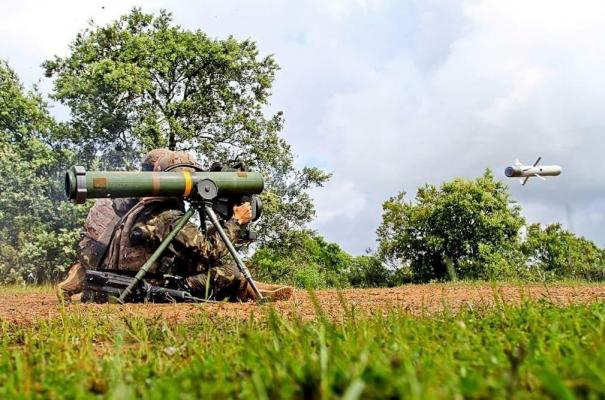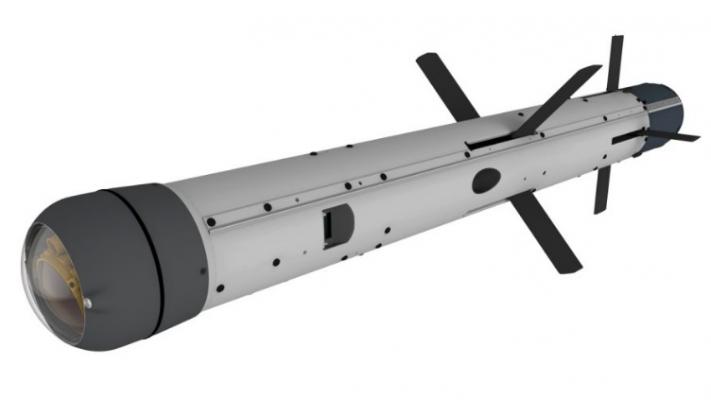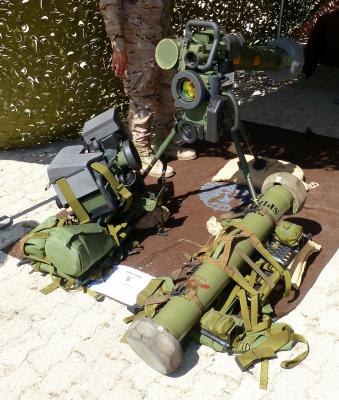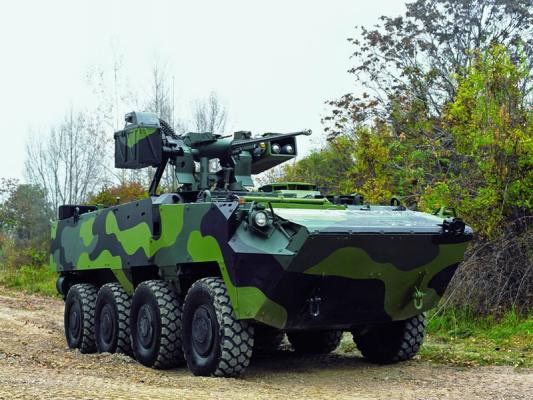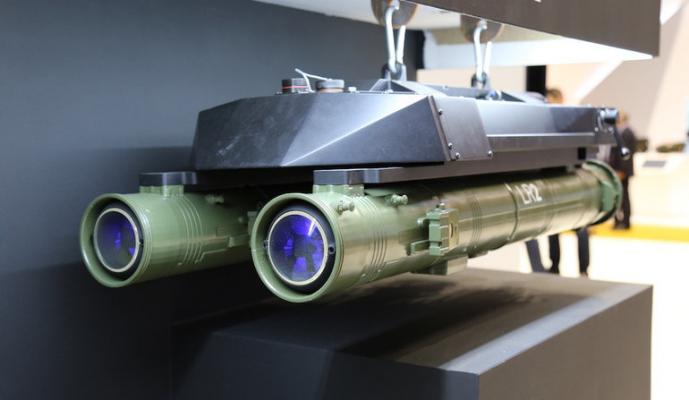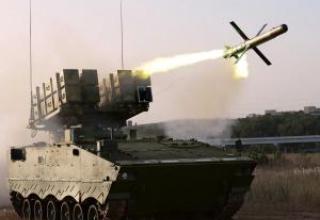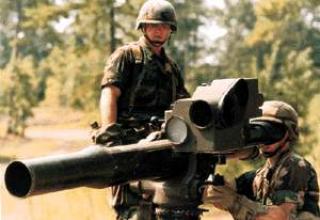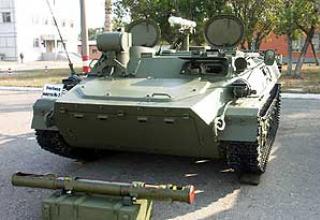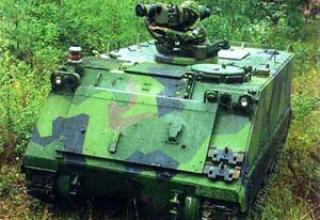The Spike-LR (Long Range) multi-purpose anti-tank missile system is designed to engage modern armored vehicles, including those equipped with dynamic protection, fortifications, enemy manpower, at any time of day, in difficult weather conditions at ranges from 200m to 4km.
SPIKE-LR is used for armament of combat helicopters, surface ships, placement on self-propelled chassis of various types, as well as in a portable version.
The SPIKE-LR is part of a family of Israeli Rafael Advanced Defense Systems, which in addition to the Spike-LR includes: light portable Spike-SR with a range up to 1500m, Spike-MR with a range up to 2500m, Spike-ER with a range up to 8000m, Spike-NLOS with a range of 25km.
In the Israel Defense Forces Spike-LR/MR complexes are in service with an anti-tank platoon of the infantry battalion's support company.
Germany has established a production line of Spike-LR complex, named MELLS (Mehrrollenfähiges Leichtes Lenkflugkörpersystem) on the sites of joint venture EuroSpike GmbH. EuroSpike GmbH was founded by the German companies Diehl BGT Defence GmbH & Co.KG, Rheinmetall Defence Electronics GmbH and the Israeli company Rafael Advanced Defense Systems. The Spike-LR complex is also produced under license at the state defence plant Mesko (Poland).
Spike-LR complex of different configurations has been adopted for service by 28 countries including Azerbaijan, Belgium, Chile, Colombia, Croatia, Czech Republic, Ecuador, Germany, India, Israel, Italy, Spain, Latvia, Lithuania, Netherlands, Peru, Poland, Portugal, South Korea, Romania, Singapore, Slovenia, Great Britain. By the end of 2016, about 27,000 missiles had been delivered.
Composition:
Spike-ER rocket is made according to the normal aerodynamic scheme with aerodynamic surfaces opening after the launch.
The homing head (Spike-ER) of the missile is located in the nose section, behind it there is an electronics unit and a leading charge of the cumulative warhead, behind which the marching engine is placed. In the central part of the hull there is a gyroscope and accumulator battery, the main charge of the combat unit with a safety executive mechanism and a fuse. The folding steering wheels with steering drives, the launch engine and the fiber optic cable reel are located in the missile's tail part.
The Spike-LR missile has a combined control system, including: a television CCD-based CNS or dual-channel CNS, in which the CCD TV matrix is supplemented with uncooled thermal imaging type IIR, as well as inertial system and data channel equipment. Bidirectional data transmission can be implemented on the basis of a radio channel or using a fiber optic communication line.
The control system makes it possible to implement a wide range of combat applications, including shot-and-forget, target acquisition and redirection after launch, command guidance and implementation of complex flight paths, shooting at an invisible target from a closed position, identification and engagement of the target in the most vulnerable parts.
According to the data provided by the Polish Ministry of Defence, the armour-piercing capability of the Spike-LR tandem cumulative ballistic missile is 700 mm of steel homogeneous armour. To engage fortifications and buildings, the Spike-LR can be equipped with a PBF (Penetration, Blast and Fragmentation) firing squad.
The average flight speed of the missile on the trajectory is 130-180 m/s. The flight time for the maximum distance is about 26 seconds.
In 2017, Rafael announced the development of an upgraded version of Spike-LR, which was designated Spike-LRII. The new missile can be used from the same PA (land, air, sea) as the old Spike-MR/LR.
The launch range of the Spike-LRII (see photo1, photo2) from the ground-based launcher is 5.5 km, when launched from a helicopter - up to 10 km. Fiber optic communication line is not used in Spike-LRII guidance system. The new missile weighs 12.7 kg and can use two types of BC: tandem cumulative with 30% increased armor penetration and multi-purpose, with different modes of operation of the fuse: in the concrete piercing mode it is ensured the penetration of 20 cm of reinforced concrete and explosion of the second charge of BC with a delay. In a mode of instant action the directed flight of fragments is provided, for the maximum defeat of a live force and the unarmed technics.
The main difference between the Spike-LRII and its predecessor is the new CNS (see photo). The Spike-LRII CNS includes an uncooled infrared matrix and a high-resolution color camera. The signal processing system uses artificial intelligence elements and is able to track different types of targets (low-contrast, fast hiding). The missile can receive target designation not only from its PU, but also from the tactical control and monitoring system.
Portable version
The portable version of Spike-LR complex (see photo1, photo2) includes:
- Spike-LR missiles in a transport and launch container (TLC);
- launcher in the composition:
- Command Launch Unit (weight 5 kg);
- lithium electric battery (weight 1kg);
- thermal imaging sight (weight 4kg);
- folding tripod (weight 2.8 kg);
- training means, consisting of field and stationary simulators, rocket training models.
The thermal imaging sight provides all-day use of the complex and includes a daytime optical sight of tenfold magnification, as well as a thermal imager with an IR detector matrix located in the focal plane of the optical system. The sight has two fields of view, a wide field of view is used for target detection, and a narrow field of view is used for target identification and guidance. The detection range of a typical target is 3 km.
The total weight of the complex in the combat ready state - 26kg. Ready to go on alert time is 30c, reload time is 15s. The unified launcher allows to use also Sike-MR (medium range) missile.
The complex as a part of the launcher and two missiles is carried in two wagons by two persons. A pack N1 with a launcher and a command and launch unit, a pack N2 - with two missiles in the TIC.
Placement options on self-propelled chassis
To accommodate the Spike-LR complex on self-propelled chassis of various types, a unified machine has been developed that requires finalization of the carrier in a minimum amount.
At the end of 2016, the Rheinmetall Group was awarded a contract by the German defence procurement agency BAAINBw (Bundesamt für Ausrüstung, Informationstechnik und Nutzung der Bundeswehr) for the integration of the MELLS (Spike-LR) Spike-LR into the Marder BMP to modernise and extend the service life of the latter. Two prototype BMPs that have been modernized in this way were successfully tested in the first half of 2017. Under a €35 million serial contract, Rheinmetall delivered 44 MELLS series kits to the Bundeswehr in December 2017, which are equipped with 35 Marder 1A5 combat trainers (battalion kit). Rheinmetall continues the integration of MELLS MCPs on Bundeswehr's Marder 1A3 and 1A5A1 BMPs.
On February 12, 2018, the Latvian Ministry of Defence signed a contract with EuroSpike GmbH to purchase a batch of Spike anti-tank missile systems for the Latvian army worth a total of 108 million euros. The delivery will take place by 2023. The Spike-LR complexes are used in the Latvian Army both in a portable version and for deployment on FV103 Spartan tracked armoured vehicles (see photo1, photo2) and HMMWV vehicles (see photo).
The Polish company Huta Stalowa Wola (HSW) has developed a remote-controlled combat module ZSSW-30, designed to be placed on the Rosomak M2 IFV combat vehicle. The ZSSW-30 module is intended to replace the manned Hitfist-30P turret and is placed on the same chase.
The module's armament includes an Mk44 30 mm automatic gun and two Spike-LR missiles. The GOC-1 NIKE sighting system is equipped with a thermal imaging camera operating in the wavelength range from 3 to 5 microns, complemented by a monopulse laser rangefinder and a high-resolution CCD television camera (see photo1, photo2). The GOC-1 NIKE can operate at any time of day or night. The angle of view is from -20° to +70° on the angle of place and 360° on azimuth.
The Samson MkI remotely operated combat module offered by Rafael has a stabilized automatic gun in the center, an optronic kit in an armored container on the right side and a container with two anti-tank missiles on the left side. In addition to the Spike-LR, Spike-ER and other PTUR models can be used as missile armament in the module.
The rifleman has an optronic day/night sight at his disposal, and the commander can independently monitor the sight thanks to the panoramic sight mounted on the mast. Samson MkI can interact with any BIS and is equipped with automatic target tracking system, capable of capturing fast moving targets. The feature of the module is that it can be removed and reduced silhouette of the vehicle when it is not necessary, and raised during combat operations.
Samson MkI was purchased by Czech army and installed on more than 100 Pandur 8x8 vehicles, some of which were deployed in Afghanistan (see photo1, photo2).
In 2013, the Rafale company completed testing of a new combat module Samson MkII. In this module, two missiles are in a row in a new retractable launcher that can accept the MR, LR and ER versions of the Spike missile (see description) .
The Spike-LR (MELLS) is also part of the armament of the new German Puma BMP company PSM (a joint venture between KMW and Rheinmetall). The Spike-LR is fitted in an armoured box on the left side of the uninhabited turret (see photo), armed with a 30mm Mk30-2/ABM automatic gun and a 5.56mm or 7.62mm twin machine gun.
Air-based options
The Spike-LR helicopter-launched APC is a part of the APC:
- Spike-LR guided missiles in transport and launch containers;
- launchers equipped with standard suspension units;
- Top Lite sighting and search system (standard information exchange MIL STD 1553).
The SPIKE-LR system enables the missile to be pointed at its target using a two-way electron-optical image transmission system via radio channel. The missiles are placed in tubular launchers, which are mounted on standard suspension units on the helicopter fuselage.
In 2005, Sagem demonstrated a striking version of the Sperwer-B unmanned aerial vehicle (see photo). The Sperwer-B is equipped with a Top Lite system and two 30 kg under-wing suspension points each, on which Spike-LR missiles can be mounted.
Shipboard versions
Spike-LR missiles are part of the Samson-RWS turret armament, which can be used to equip small displacement boats and patrol ships (see photo).
Characteristics:
| Spike-LR I | Spike-LR II | |
| Range of fire, m | 200-4000 | 200-5500 |
| Flight Speed, m/s | 130-180 | |
| Armor-piermeable, mm | 700 | 900 |
| Diameter TPK,mm | 170 | |
| Weight of the rocket in the TPC, kg | 13.5 | 12.7 |
| Alert time, s | 30 | |
| Recharging time, s | 15 | |
| Temperature range of combat application, C | between -32 and +49 | |
| Storage Temperature, C | between -45 and +71 |
Testing:
In 2009, between 244 and 288 Spike rockets and 24 launchers were purchased by Peru (total contract amount was between $48 and $55.8 million). During the test firing on 16 April 2010, two rockets were fired. The first was fired during the day and successfully hit the target. The second was fired during the night, but the marching engine did not start and the rocket fell half a m away from the launch point but did not explode.
In early May 2010, the head of Rafae visited Lima and explained to the customer the reasons for the incident, which he called "an unexpected accident". He said that "... Spike's APCs have been delivered to 17 armies around the world, including the Israel Defense Forces; more than 1,800 rockets have been fired, and the reliability level is about 95%". After the meeting, the Defense Ministry and the Peruvian Army Command "decided to require the supplier to exchange the supplied missiles for newer ones".
Sources:
- Spike LR Long Range AT Missile /defense-update.com/
- Misil Spike
- Германские боевые машины пехоты Marder получают противотанковые ракеты Spike-LR
- Новый вариант израильской ПТУР Spike-LR
- Многофункциональный противотанковый ракетный комплекс Spike (Израиль) /ВТС «Невский бастион»/
- Poland Equip Rosomak IFVs with ZSSW-30 Remote Turret
- «Рафаэль» представляет новый вариант ПТУР Spike
- Латвия приобретает крупную партию израильских противотанковых ракетных комплексов Spike
